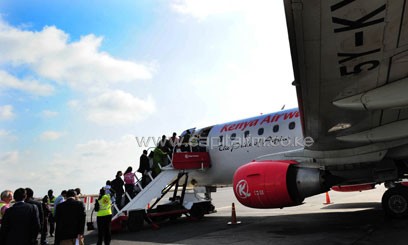This plan will be driven by targeting under-served African regional and domestic markets with mid-range aircraft types like Embraer E-Jets which are more cost efficient.
“The E-Jets give us a fantastic opportunity to open up routes that do not have a lot of capacity, but a lot of potential that could be served by large aircraft,” KQ Chief Executive and Managing Director Titus Naikuni said during a cocktail event marking the arrival of the airline’s latest E-Jet.
The move to broaden its presence in the African market as an alternative revenue stream is to compensate for dwindling traffic from European markets and growing competition.
Last year, the airline raised 50 percent of its revenue from Africa, with Europe accounting for 26 percent.
The planned destinations include: Juba, Luanda, Bangui, Douala, Yaoundé, Kigali, Entebbe, Dar-es-Salaam, Kinshasa and Bujumbura.
Over the last 10 years African airlines have gone down by almost 10 percent in terms of market share in the continent, from 56 percent to 47 percent, while the Middle East airlines have climbed from eight percent to 15 percent in the same period.
Qatar Airways, for instance, is in talks with the government to begin direct flights to Mombasa.
European airlines are also starting to face downwards to Africa moving their market share from 34 percent to 38 percent.
According to the Africa Airline Association, there are about 660 regional and domestic city-pairs in Africa, more than half of which are served by less than five flights a week, and 12.5 percent served by just one flight per week.
Over the next 20 years, Africa traffic is forecast to grow at an average of 5.4 per cent annually.
Locally, the Kenya Airports Authority estimates that passenger traffic will grow from 5.48 million in 2010 to 17 million by 2020 and 35 million by 2030.
At the moment, the airline has 14 E-jets, but plans to increase the number to 20 by the end of 2013.
Under its 10 year strategic plan, KQ intends to increase the size of its fleet from the current 37 aircraft to 119 by 2021.
The airline is also building its human resource embarking on a training programme for career entry pilots to operate the aircraft.
At the moment, about 100 young pilots are undergoing training the ab initio with almost 100 pilots currently in training that will join the ranks to operate the E-jets.



































